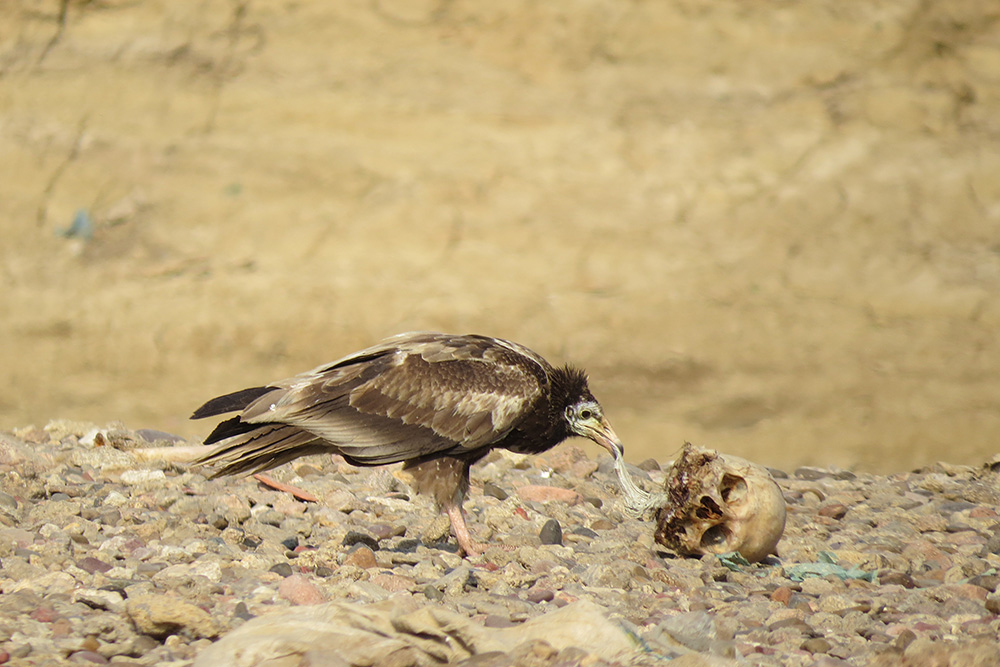
An Egyptian Vulture (Neophron percnopterus) feeding on soft tissue from a human skull on the Ken River (near Banda, Uttar Pradesh), December 2013.
River banks across much of north India are used to cremate or immerse the dead, and it is not uncommon to see partly burnt and unburnt corpses along these rivers. Many such remains are eventually consumed by a host of wildlife including vultures, jackals, fish, turtles and crocodiles, wherever they occur, and in the process these corpses undergo atleast an organic reincarnation. While some regard this as an ecosystem service, which it arguably is, are we inadvertently putting our wild scavengers at risk?
At the time of dying our bodies are often a cocktail of pharmaceutical potions and poisons, especially in the case of an infection or infirmity. While the lethal effects of veterinary use of diclofenac on India’s vultures are well established, very little is known about the dangers of such non-steroidal anti-inflammatory drugs (NSAIDs) and other pharmaceutical residues in human corpses. It is therefore necessary to investigate the potential risks they pose rather than witness the dramatic decline of yet another unwitting ‘indicator’ species. It may only be a matter of looking for the next chemical culprit.
A recent theme issue of the Philosophical Transactions of the Royal Society assesses the risks of ‘medicating the environment’ and the impacts of these pharmaceuticals in the environment on wildlife and ecosystems. Since pharmaceuticals are generally not intended to kill organisms outright and they persist in the environment for long periods, their effects may not necessarily be sudden and dramatic. But the threats are real. Some well-known examples of the effects of pharmaceuticals, reported therein, include the feminization of male fish exposed to effluent containing synthetic oestrogen discharged by wastewater treatment plants; intersex frogs found in urban ponds contaminated with wastewater; and immuno-suppression in adult and nestling starlings, and changes in behaviour and brain structure of adult males starlings after consumption of endocrine-active chemicals.
Aquatic ecosystems, especially rivers, are particularly vulnerable to pharmaceutical pollution because of the multiple direct and indirect dispersal pathways for these chemicals and because rivers eventually serve as sinks or conduits for most washed down pollutants. And we are at risk too. These chemicals have been implicated in birth defects, neurological disorders and precocious puberty, among other ill-effects. And because of our reliance on these very rivers for drinking water and food production (irrigation, fisheries, etc), the dangers of bio-accumulation and bio-magnification of pharmaceuticals are ever present.
While some argue that the environment is resilient, this resilience may not necessarily suit our fancy. Take microbial drug resistance for instance. Our unrestrained use of pharmaceuticals has led to microbes developing resistance, through mutations, to a wide range of antibiotics and this has come back, sorely, to bite us. Given the impacts of these pharmaceuticals on the environment, shouldn’t we dispose the deceased more thoughtfully, lest they sin even in death?

 CI is a non-profit, non-commercial portal that aims to facilitate wildlife and nature conservation by providing reliable information and the tools needed to campaign effectively.
CI is a non-profit, non-commercial portal that aims to facilitate wildlife and nature conservation by providing reliable information and the tools needed to campaign effectively.
Chosen as 'Picture of the Week'
River banks across much of north India are used to cremate or immerse the dead, and it is not uncommon to see partly burnt and unburnt corpses along these rivers. Many such remains are eventually consumed by a host of wildlife including vultures, jackals, fish, turtles and crocodiles.